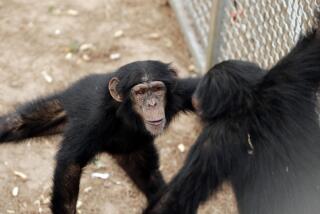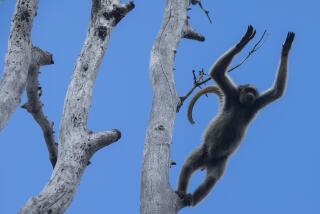Fossil finds hint at when apes and monkeys went separate ways
- Share via
Scientists have added two species of ape and monkey to the evolutionary tree, filling in a 10-million-year gap in the fossil record from a period when apes and Old World monkeys diverged.
Fossil specimens of jaws and teeth, collected by Ohio University researchers in the Rukwa Rift Basin of Tanzania, date the primates to about 25.2 million years ago. Each was probably evolving separately by then, according to the scientists, whose work was published in the journal Nature.
Rukwapithecus fleaglei was identified as a hominoid predecessor to the modern ape or chimpanzee, and Nsungwepithecus gunnelli was believed to be an early cercopithecoid, or Old World monkey, similar to a baboon or macaque.
The primates lived during the Oligocene epoch, which lasted from about 34 million to 23 million years ago, at a time when mammals began to evolve rapidly. Piecing together the narrative from the fossil record, however, has proved tricky.
“The late Oligocene is among the least sampled intervals in primate evolutionary history, and the Rukwa field area provides a first glimpse of the animals that were alive at that time from Africa south of the equator,” said Ohio University paleontologist Nancy Stevens, who led the research.
The research team also helped reconcile “molecular clock” analyses of the fossil record that trace the timing of DNA mutations. Those analyses suggest the two primates diverged about 25-30 million years ago, roughly when tectonic activity and volcanic eruptions are thought to have aided the evolutionary divergence of the primates, according to the research team.







